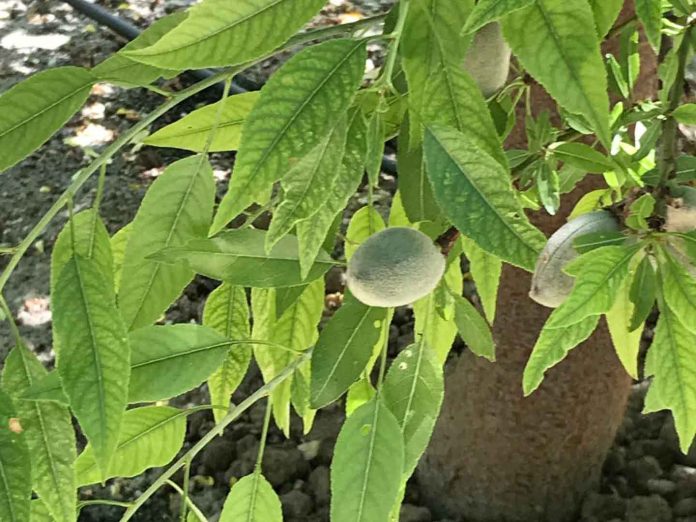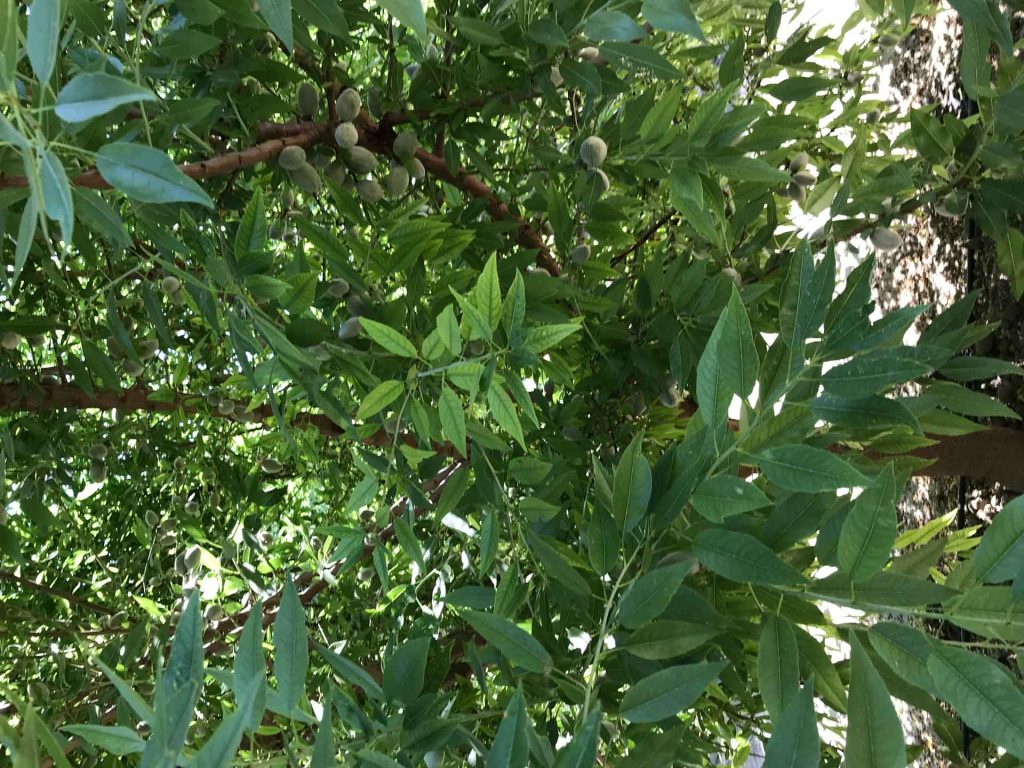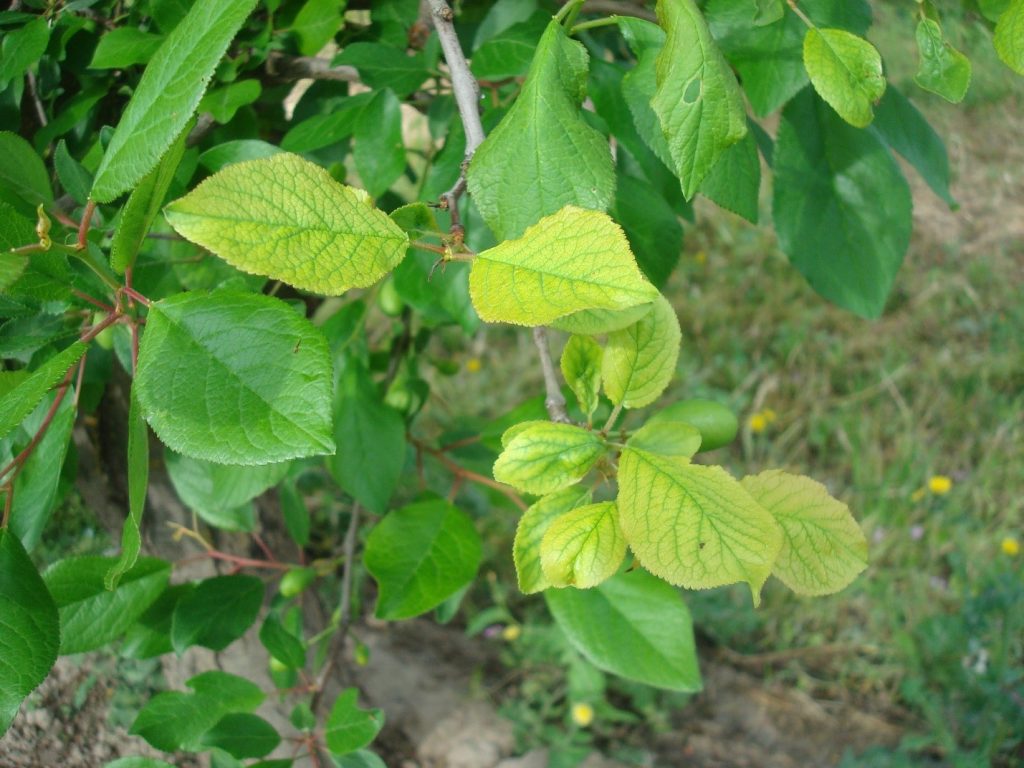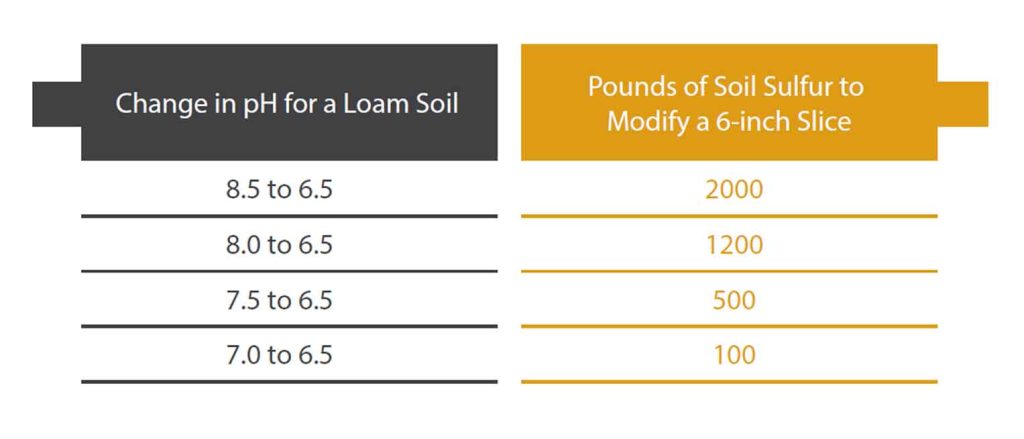
Micronutrients play a very important role in fruit and nut tree growth and development. Iron (Fe), which is an immobile micronutrient in the plant, is associated with chloroplasts and plays a role in chlorophyll synthesis. While Fe is considered the fourth most abundant element in the Earth’s crust, approximately five percent by weight, iron deficiency is a worldwide problem, and a common micronutrient deficiency in fruit and nut crops (Figure. 1) though it is uncommon in California.
Many orchards in the Central Valley are on semi-arid soils in areas where the evapotranspiration exceeds precipitation. Arid and semi-arid soils can also be found in the southwestern USA and the Mediterranean areas. In this article we will be focusing more on calcareous soils with free calcium carbonate (CaCO3) and soil solution pH in the alkaline range (i.e. above 7.5).
Before we get into the specifics of iron in the soil solution, we’ll give a brief description of pH. It indicates the concentration of H+ ions (protons) in a solution. Soils with low pH have more H+ ions than soils with a high pH. Because the equation is actually a logarithm (Equation 1), the amount of H+ ions does not increase linearly as pH decreases, it increases by a factor of 10. Thus, water with a pH of 5 has 10 times the amount of H+ protons than water with a pH of 6. Therefore, it is progressively harder to correct soil pH the farther it is from 7.
pH = -log[H+]
Equation 1: equation for conversion of the concentration of H+ ions in solution to pH. Since the equation is logarithmic, there is a 10x difference between consecutive values.
Soil pH is important as the different soil minerals that contain and release iron (Fe) into the soil-water solution decrease in solubility as pH increases, which results in only a tiny fraction of the total Fe that is in the soil to be available. In general, iron is more soluble and more available as pH decreases (acidic soils). Plants absorb some iron by diffusion at the root tips from the soil solution, and iron deficiency in California is mainly due to plants’ inability to take up iron due to soil factors such as poor soil aeration and/or high concentration of HCO3- in the soil.

interveinal chlorosis.
Under low iron availability in the soil, the ability of trees and plants to mobilize iron immediately around the root is due to differences in genes between species. Scientists have categorized plants either as “Strategy I’ or ‘Strategy II’ based on their ability to mobilize Fe in the soil and make it available for uptake. Strategy I plants include all plants except grasses and include fruit and nut trees, while Strategy II plants comprise grasses such as wheat and corn. Under Fe deficient soil conditions, Strategy I plants excrete H+ into the soil, which acidifies it and makes iron more available for uptake.
In poorly aerated calcareous or saturated soils, carbon dioxide will become trapped in the soil due to poor gas exchange with the atmosphere. This will cause the production and accumulation of bicarbonates as a result of the interaction between CO2 and calcium carbonates in the soil. Bicarbonates react with the H+ released by roots and interfere with their ability to increase iron availability.
Symptoms of Iron Deficiency
The development of Fe deficiency symptoms is most prominent on young, newly developing leaves (Figure 2) because this element is immobile in the plant. The symptoms are characterized by interveinal chlorosis, (Figure 3). Under severe conditions, leaves have a white coloration due to the disappearance of chlorophyll, and leaves can turn necrotic and abscise. Leaf chlorosis due to iron deficiency reduces photosynthesis and will result in reduced fruit yields and fruit quality. These attributes are only for iron deficient plants; overfertilizing with iron will not increase these functions in the plant.
Pre-Plant Management of Iron Deficiency
The first step in assessing an orchard is site selection, followed by collection of representative soil samples for analysis based on the United States Department of Agriculture (USDA)/National Resources Conservation Service (NRCS) soil survey map. Send these soil samples to a commercial laboratory you trust to look at soil pH and the presence of free lime. It’s also helpful to get a water analysis to look for water pH and bicarbonates. When choosing a site, try to plant in a well-drained soil. Adequate root aeration will reduce the likelihood of iron chlorosis occurring. If the irrigation water contains more than 2 meq/L of bicarbonates, you may consider acidifying the water to a pH of 6.5 to reduce bicarbonate levels by 50 percent and prevent lime buildup in the soil and in your irrigation system. An agricultural laboratory can do a titration curve, which will tell you how much acid to add to decrease the water pH. We do not recommend decreasing irrigation water pH below 5.0. Alternatively, 133 pounds of 100 percent sulfuric acid will neutralize 1 meq/l per acre-foot of bicarbonate in irrigation water. Water acidification can be achieved by using acids such as sulfuric or phosphoric acid. Make sure you tell your laboratory what acid you intend to use, as substituting one acid for another can result in incomplete or over-acidification. Urea sulfuric acids, such as N-PHuric 10/55 and US-10, will also acidify the soil and are safer to handle, however, application rates should not exceed nitrogen (N) crop requirements, which limits its use for acidification. Some growers use a “sulfur burner”, which will convert elemental sulfur into sulfurous acid (H2SO3) by burning elemental sulfur in a small furnace producing sulfur dioxide (SO2). Combination of SO2 and water in the machine will form sulfurous acid that is injected in the irrigation system. Sulfurous acid is safer than sulfuric acid injection. Sulfur burners have a minimum design and production capacity potentially making the capital investment too expensive for smaller farms to consider.

Acidification can be expensive and in extreme cases may not be viable to reduce pH in soils with a lot of free lime, as it will require large quantities of acid forming amendments to react with soil lime before the bulk soil pH begins to decrease. It takes approximately half a ton of soil sulfur to break down one percent calcium carbonate in one acre-inch of soil. To manage these costs, soil amendments such as elemental sulfur or sulfuric acid can be banded or shanked in the tree row before planting. However, warm soil temperatures and soil bacteria are needed to convert the elemental sulfur to sulfuric acid and depending on the source of sulfur and its influence on particle size, structure, and solubility of the sulfur this may take several weeks to years to break down. Acids work much faster but are more expensive. It is important to remember that any acidification will break down free lime in the soil before the bulk soil pH is changed.

Handbook, 9th Edition.
Rootstock choice is one of the most important choices you or your client will make before planting an orchard. This choice should be based on the site challenges such as pH, salinity, nematodes, and risk of bacterial canker, for example. If high soil pH and concern about iron deficiency is the most important factor to resolve, then use of Fe deficiency tolerant rootstocks is a good solution. Some of the rootstocks that are considered tolerant include some of the (peach X almond) hybrids such as Hansen 536, Bright’s, Titan, and Paramount (GF 677). However, these rootstocks are very susceptible to other soil issues such as poor drainage and root diseases, so pick your rootstock carefully. Other rootstocks tolerant to Fe deficiency are Krymsk86 which is a peach/plum hybrid used for almonds and Gisela 5 used for cherry trees.
Post-Planting Management of Iron Deficiency
After planting the trees, if your soils do not have a large amount of free lime, the best management practice is acidifying the soil around the root zone. This can be done using elemental sulfur or the injection of acids as described before, however you can easily damage your trees through acid injection so follow directions carefully. Do not apply sulfuric acid in established orchards at more than 1500 lbs per treated acre to prevent tree damage. Elemental sulfur takes longer but is safer for the trees. It is often more economical to acidify a band of soil rather than attempting to acidify the entire root zone.
Another way to correct iron deficiency after planting is to apply foliar and soil chelated Fe which will result in a faster response. However, it is short-lived, expensive, and can be leached below the root zone under heavy irrigation. Chelated Fe most likely will need to be applied multiple times in the orchard’s lifetime. Applications of ferrous sulfate to the soil or the tree is a cheaper option compared to chelated Fe. However, in calcareous soils it will very quickly become unavailable for uptake and is not an appropriate option in these soils.
Sources:
Elkins, R., and Fichtner, E. (2012). Causes and control of lime-induced Fe deficiency in California fruit and nut crops. CAPCA (California Association of Pest Control Advisers) Advisor. August 2012.
Lauchli, A., and Grattan, S., R. (2012). Soil pH Extremes in: Plant Stress Physiology. CAB International, Editors: S Shabala, pp.194-209.
Sanden, B., L., Prichard, T., L., and Fulton, A., E. 2016. Assessing and Improving Water Penetration in: Pistachio Production Manual. UC ANR publication 3545, Editors Louise Ferguson and David Haviland, pp. 141-152.
Tagliavini, M., and Rombola, A., D. 2001. Iron deficiency and chlorosis in orchard and vineyard ecosystems. European Journal of Agronomy 15: 71-92.

















[…] © Progressive Crop Consultant […]